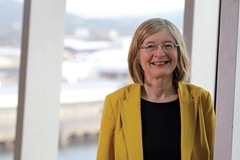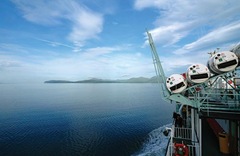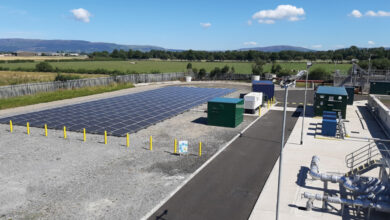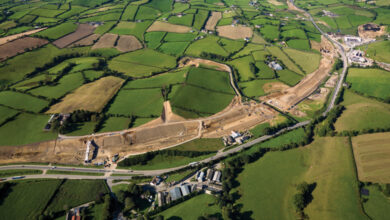Marine Scotland: managing Scotland’s seas
 Renewable energy development in Scotland’s seas must be balanced with the needs of the environment and local communities. Peter Cheney talks to Marine Scotland’s Director, Linda Rosborough, about how it manages the marine environment.
Renewable energy development in Scotland’s seas must be balanced with the needs of the environment and local communities. Peter Cheney talks to Marine Scotland’s Director, Linda Rosborough, about how it manages the marine environment.
Around one quarter of Europe’s tidal and offshore wind potential lies off the coast of Scotland but renewable energy is only one of many interests that need to be considered by the country’s marine planners.
Linda Rosborough is Director of Marine Scotland, a division of the Scottish Government established in 2009 to “manage Scotland’s seas for prosperity and environmental sustainability”. It reports directly to ministers and is also responsible for Scotland’s approach to fisheries negotiations.
“We’ve been able to integrate the way in which the marine environment is managed,” Rosborough comments, “so that’s brought together a lot of disparate processes into one place and it means that we can understand more about the environment.” Scotland’s Marine Atlas, for example, brings together information on nature conservation, archaeology, the sea’s physical and chemical characteristics and how people use it for recreation and for the economy.
Marine Scotland is an example of a fully operating marine management organisation (MMO) and Environment Minister Alex Attwood is also seeking to persuade fellow Executive ministers to establish an MMO for Northern Ireland.
“There’s so much that we still don’t know about the sea,” she adds. “There’s so much that we need to understand and it’s expensive. It takes a lot of work and a lot of time but we need to just continue to focus our efforts and share understanding and get the most out of the resources that we have.”
Scotland’s coastal communities are “very varied” and include almost 100 inhabited islands. Rosborough also differentiates between “communities of place” and “communities of interest” e.g. yachtsmen, fishermen, and oil and gas workers. Marine Scotland ensures that both types of communities are involved in all its policies and in regulatory work “before we come to decisions.”
Rosborough, who is originally from Northern Ireland, was visiting Belfast to speak at agendaNi’s seminar on facilitating offshore renewable energy. Setting the context for delegates, she explained that the EU Marine Strategy Framework Directive aims to achieve good environmental status in all of Europe’s seas by 2020. Marine planning recognises that “as use of the sea becomes greater, we need to have a formal way of managing who gets to use the sea, when and in which circumstances.”
Marine Scotland aims to create a one-stop shop for the various consents needed at sea e.g. for fishing, navigation and generating electricity. It also has a duty to establish a network of marine conservation sites by 2015, under the Birds and Habitats Directives.
The Scottish Parliament is responsible for inshore waters (up to a limit of 12 nautical miles), including those around St Kilda and Rockall. The UK Parliament is, meanwhile, responsible for the offshore area i.e. between 12 and 200 nautical miles offshore, or until it reaches an international maritime boundary.
In 2011, the UK and devolved governments agreed the Marine Policy Statement, which covers all UK waters and sets down a consistent framework for planning.
 A national marine plan for Scotland is due to go out for consultation early next year and the marine atlas forms the “evidence layer” for this plan. It also gives developers a “first glance” of areas where there are opportunities or constraints, and helps the general public understand the sea better. Two copies were sent to every secondary school in Scotland.
A national marine plan for Scotland is due to go out for consultation early next year and the marine atlas forms the “evidence layer” for this plan. It also gives developers a “first glance” of areas where there are opportunities or constraints, and helps the general public understand the sea better. Two copies were sent to every secondary school in Scotland.
The final marine plan is due to be published by the end of 2014. After that stage, some marine planning responsibilities will be delegated to local ‘marine partnerships’, which will include members from local authorities and conservation, commercial and recreational interests.
In the meantime, her staff are meeting coastal residents by running drop-in centres during the day and hosting evening meetings. The more remote areas (Shetland, Orkney and the Western Isles) have “very strong identities” and “a long history of doing things their own way”.
Rosborough stated that developers must demonstrate the benefit to communities if they are to win their support. The oil and gas industry, she noted, “took grounds away from fishing but gave fishermen jobs” in guard ship duties and supply work: “If you can learn from that and do the same sort of thing in how you bring forward your renewables proposals, then you’ll go a long way to working in partnership and harmony with these sectors rather than against them.”
The onset of marine renewables made this a “very exciting time” for those involved in Scotland’s seas. Marine Scotland had just received the first application under the Crown Estate’s Round 3 leases: 339 turbines in the Moray Firth with a potential capacity of 1.5GW.
However, she cautioned that renewable development must be balanced with the needs of other marine users. Compared to the land, the sea is a “multi-use” environment. An apparently empty space with good potential for renewables may also be used by fishermen or as a holding area for ships waiting to dock at port.
The marine plan will take a sector-by-sector approach, which looks for the best locations for each activity. Fishing boats will be allowed to catch the ‘maximum sustainable yield’ of fish offshore but Scotland also hopes to double the size of its aquaculture industry by 2020.
A considerable amount of time is being spent on building up the evidence base. Marine Scotland is now mapping the seabed, particularly areas where early development is likely, and making topographical data available as quickly as possible. Other bodies (e.g. the Crown Estate) are contributing datasets and Rosborough welcomes the different parts of government working together, sharing expertise and minimising duplication.
This surveying work has been prioritised so that that investors and developers can have more confidence in where they can and cannot build. In summary, she remarked: “What we’re looking for is not development at any price but the right developments in the right locations.”





